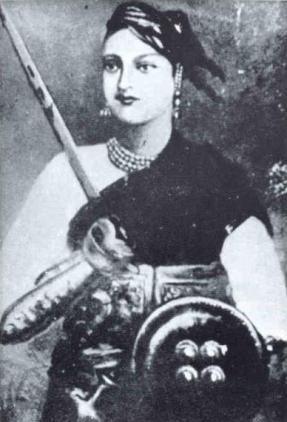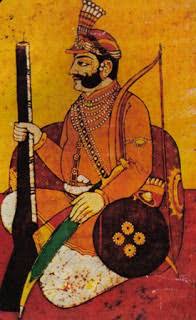
Lakshmibai Newalkar, the Rani of Jhansi, was the Maharani consort of the princely state of Jhansi in Maratha Empire from 1843 to 1853 by marriage to Maharaja Gangadhar Rao Newalkar. She was one of the leading figures in the Indian Rebellion of 1857, who became a national hero and symbol of resistance to the British rule in India for Indian nationalists.

Bundelkhand is a geographical and cultural region and a proposed state and also a mountain range in central & North India. The hilly region is now divided between the states of Uttar Pradesh and Madhya Pradesh, with the larger portion lying in the latter state.

Jhansi is a historic city in the Indian state of Uttar Pradesh. Balwant Nagar was the old name of Jhansi. It lies in the region of Bundelkhand on the banks of the Pahuj River, in the extreme south of Uttar Pradesh. Jhansi is the administrative headquarters of Jhansi district and Jhansi division. Also called the Gateway to Bundelkhand, Jhansi is situated near and around the rivers Pahuj and Betwa at an average elevation of 285 m (935 ft). It is about 420 kilometres (261 mi) from national capital New Delhi and 315 kilometres (196 mi) from state capital Lucknow.

Datia is the district headquarter of the Datia District in north central Madhya Pradesh,a state of Central India. It is an ancient town, mentioned in the Mahabharata ruled by King Dantavakra. The city is 78 km from Gwalior, 325 km south of New Delhi and 344 km north of Bhopal. About 18 km from Datia is Sonagiri, a sacred Jain hill. Datia is also about 31 km from Jhansi and 52 km from Orchha. The nearest airport is at Gwalior. It was formerly the seat of the eponymous princely state in the British Raj. Datia is situated near Gwalior and on the border with Uttar Pradesh.

Chhatrasal Bundela was the Raja of Panna from 1675 to 1731. He is well known for his Resistance against the Mughal Empire.

The Bundelkhand Agency was a political agency of the British Raj, managing the relations of the British government with the protected princely states of the Bundelkhand region.
The Central India Campaign was one of the last series of actions in the Indian rebellion of 1857. The British Army and Bombay Army overcame a disunited collection of states in a single rapid campaign, although determined rebels continued a guerrilla campaign until the spring of 1859.

Ek Veer Stree Ki Kahaani – Jhansi Ki Rani is an Indian historical drama based on the life of Lakshmi Bai, the Rani of Jhansi. The series was directed by Jitendra Srivastava and written by Rajesh Saksham, Ila Dutta Bedi, Malavika Asthana, Mairaj Zaidi. It premiered on 18 August 2009 on Zee TV with Ulka Gupta playing young Queen Lakshmi Bai. On 8 June 2010, the story moved on several years and Kratika Sengar portrayed the Queen from there on. The last show episode aired on 19 June 2011 completing 480 episodes.

Orchha State was a kingdom situated in the Bundelkhand region and later a princely state in British India. The state was ruled by Bundela clan of Rajputs. It was located within what is now the state of Madhya Pradesh.

Khaniadhana or Khaniyadhana was a princely state of British India ruled by the Judev dynasty of Bundela Rajputs. The capital of the State was Khaniadhana. It was part of the Bundelkhand Agency and later the Central India Agency.

Jhansi was an independent princely state ruled by the Maratha Newalkar dynasty under suzerainty of British India from 1804 till 1853, when the British authorities took over the state under the terms of the Doctrine of Lapse, and renamed it the Jhansi State. Before the takeover, it was under the Peshwas from 1728 to 1804. The fortified town of Jhansi served as its capital.

Maharaja Gangadhar Rao Newalkar was the 5th Raja of Jhansi situated in northern India, a vassal of Maratha Empire. He was a Marathi Karhade Brahmin. He was the son of Shiv Rao Bhau and a descendant of Raghunath Hari Newalkar.
The Bhat Peshwa family earlier known as Bhat family is a prominent Indian Chitpavan Brahmin family who dominated India for around 100 years in the late 18th century and early 19th century. Most of the members in this family were the Peshwas in the Peshwa Era of the Maratha Empire, and Peshwa later became their family name. During their regime, most of the Indian subcontinent was under their control. The last Peshwa, Baji Rao II, was defeated by the British East India Company in the Third Anglo-Maratha War in 1818. The territory was annexed to the British East India Company's Bombay Presidency, and he was pensioned.

Damodar Rao was the adopted son of Maharaja Gangadhar Rao and Rani Laxmibai of Jhansi State.
Lakhsman Rao Jhansiwale (1904–1959) was son of Damodar Rao of Jhansi, the adopted son of Raja Gangadhar Rao and legendary Rani Laxmibai of Jhansi State.

Manikarnika: The Queen of Jhansi is a 2019 Indian Hindi-language historical action drama film based on the life of Rani Lakshmi Bai of Jhansi. It is directed by Krish Jagarlamudi and Kangana Ranaut from a screenplay written by V. Vijayendra Prasad. Produced by Zee Studios, the film stars Ranaut in the title role.

Khoob Ladi Mardaani – Jhansi Ki Rani is an Indian historical drama television series based on the life of warrior queen Lakshmi Bai, the Rani of Jhansi. The show, starring Anushka Sen went to air on Colors TV on 11 February 2019. Due to low TRPs, the show ended on 12 July 2019 completing 110 episodes. It was replaced by Bahu Begum.

Newalkar dynasty were Marathi Karhade Brahmins, who were the Maharajas of Jhansi from 1769 to 1858. Their family deity was goddess Mahalakshmi. The Newalkars were sardars under Peshwa Madhavrao I, and later became Maharajas of Jhansi in Central India as an independent member of the Maratha Empire until 1818. Later, their kingdom became a princely state under the protectorate of British India.

Tantia Tope was a notable commander in the Indian Rebellion of 1857.

The Indian independence movement was a series of historic events with the ultimate aim of ending British rule in India, lasting from 1857 to 1947. Women played a pivotal role in achieving India's independence. However, their lives, struggles, and contributions to the movement are never recognized at the same level of prominence as that of the men of the movement. Additionally, their names are seldom heard when discussing the independence movement, or mentioned in brief. Woman’s participation in India’s freedom struggle started as early as 1817. Bhima Bai Holkar fought against the British Colonel Malcolm and defeated him in guerrilla warfare. Throughout the twentieth century, numerous women continued to contribute to the movement through military leadership, political leadership, and social activism.






















